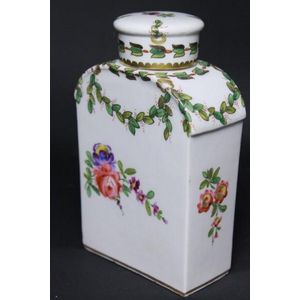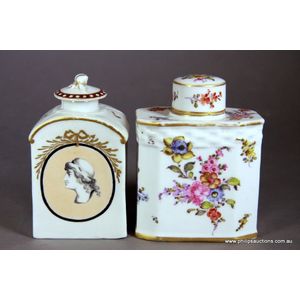Porcelain Tea Caddies - Thuringian & Samson, 1800s
Two porcelain tea caddies by Thuringian and Samson, 1800 and later 19th century, a Thuringian tea caddy of arched form with a monochrome profile portrait bust of Julius Caesar and spouse, and a floral decorated rectangular caddy with canted corners and an osier border, bearing a mock Ludwigsburg lozenge underside. Height 12 cm
You must be a subscriber, and be logged in to view price and dealer details.
Subscribe Now to view actual auction price for this item
When you subscribe, you have the option of setting the currency in which to display prices to $Au, $US, $NZ or Stg.
This item has been sold, and the description, image and price are for reference purposes only.
- Monochrome / Monochromatic - A painting or drawing finished in a single colour, or in different shades of a single color.
- Canted Corners - In decorative arts, especially furniture making, a canted corner refers to a technique where the corner of the piece is angled or "canted" to create a diagonal corner. This is different from a chamfered corner which is a technique where the edges of a corner are cut at an angle, creating a diagonal edge or "bevel" along the corner.
A canted corner is typically used to add visual interest to the item. It can be found in various styles of furniture such as contemporary, Art Deco, or traditional. It is often used to create a sense of movement and dynamism in a piece.
Canting a corner is a more complex technique than chamfering, and it is typically done by tilting the corner of a piece of furniture and then cutting the wood to match the angle. It's a technique that requires precise measurements and a good understanding of angles and geometry, and it is usually done by experienced artisans. - Osier / Ozier Pattern - When used to decorate porcelain, the osier / ozier pattern is a decorative technique that creates a woven or basket-like pattern on the surface of the ceramic. The pattern is created by using a small, pointed tool to incise lines into the surface of the porcelain, creating the appearance of woven strands. It adds a subtle yet interesting texture to the surface of the piece. The pattern can be applied in a variety of ways, such as in a random or structured arrangement, and can be combined with other decorative techniques, such as hand-painted designs or gold leaf accents.
This item has been included into following indexes:
Visually similar items

Sold by
in
for
You can display prices in $Au, $US, $NZ or Stg.

An early hand decorated porcelain tea caddy, no damage.
Sold by
in
for
You can display prices in $Au, $US, $NZ or Stg.

Three Chinese inside-painted glass snuff bottles, Ding Guilin, Cha Yuging, Yao Guixin, 1970s 8 cm, 7.5 cm, 8 cm (3). Provenance: Purchased at Pecking Arts & Crafts in the late 1980s and early 1990s Pecking Arts & Crafts
Sold by
in
for
You can display prices in $Au, $US, $NZ or Stg.

Pair of Sampson of Paris tall lidded tea caddies decorated with cresting (the lids have been glued on)
Sold by
in
for
You can display prices in $Au, $US, $NZ or Stg.
